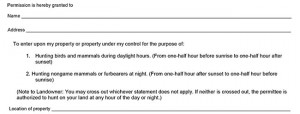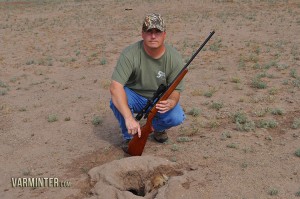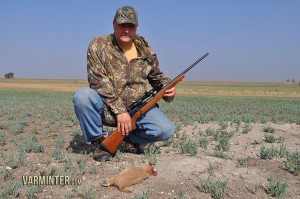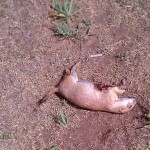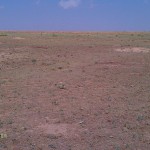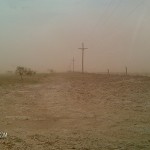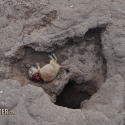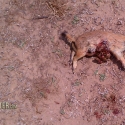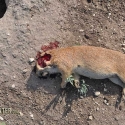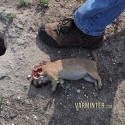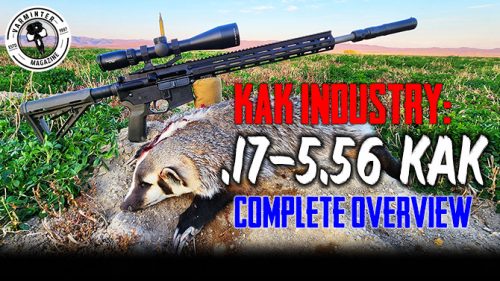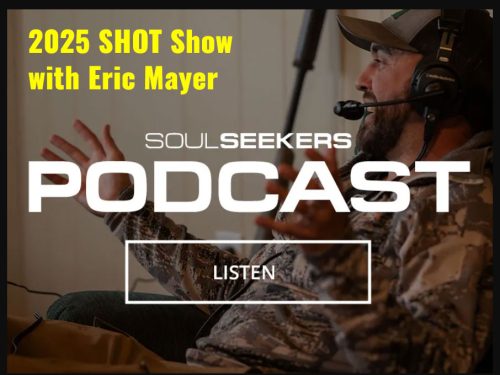When it comes to varmints, Texas offers tons of opportunities to those who can find property to hunt. Varmint hunters are generally welcomed by landowners, so I have found it easier to gain access when they know I only want to target the critters that don’t have horns or tusks. This was the case during a trip we made to Texas where the main target for our last week of hunting was Prairie Dogs. This article is about our Texas Prairie Dog Hunt and hints on finding land to hunt.
After leaving the Abilene area, my cameraman (Tom) and I headed up to the bottom of the Panhandle of Texas, ending up in Lubbock. We knew the drought had hit that area of Texas hard, so our hopes of finding some decent numbers of hunt-able prairie dogs were not high. After checking into our motel, I opened up Google Maps/Satellite and scoured the areas outside of town looking for signs of prairie dog towns. For those who have read about the methods I’ve used in the past, you should already know that using the tools provided to you on the internet can cut down on a lot of driving and allows you to focus in on one area when looking for permissions. There is a quote from the movie, “The Outlaw Josie Wales” where Captain Terrill says the following about Clint Eastwood’s lead character, “Not a hard man to track. Leaves dead men wherever he goes.” The same kind of thinking applies to prairie dogs, but they leave HOLES wherever they go. So find the holes and most of the time, you’ll find the prairie dogs. This time was no different.
I located some remnants of prairie dog towns on the net, so we started out the next morning and worked our way into some of the smaller farming towns outside of where we were staying, looking for prairie dogs and permission to hunt them. We ended up hitting about 4 city offices to see if they knew of anyone having issues with prairie dogs. We lucked out in one town, where they directed us to the local county public works department. The guys there directed us to a farm outside of town that had some prairie dogs on it. Upon arrival at the farm’s equipment yard, there was no one to be found. It’s always awkward for me when I am on someone’s property, unbeknownst to them, searching for someone to speak to. I’m always expecting someone to come out with a shotgun pointed at my face, telling me to “get off their lawn” (I know, another Clint Eastwood line)… We waited for around 30 minutes when a pick-up truck came rolling into the yard. I introduced myself, explained why I was there, then asked if they had any property we could shoot for prairie dogs. The farmer was very nice and immediately got on the phone with his father, who was up the road on one of the pastures working. We were given directions to the pasture where the farm owner would meet us and show us where we could shoot!
As we drove through the fields, we could see how badly the drought had affected the area. It was windy (when is it NOT windy in this area of Texas?) and the dust filled the air, making it look like a storm was moving in, but we were determined to get hunting. The farmer met us and apologized that the best place to shoot prairie dogs was occupied at the moment by a vacuum truck belonging to someone who sells baby prairie dogs he sucks up to the pet shops in town (more on that at the bottom of this article). He directed us to another pasture that also held decent numbers, so we shook hands and went to go find some targets!
We finally got to the pasture and unloaded all our gear. It was way too windy to record anything on video, so Tom grabbed his Ruger 77/22 K-Hornet and I grabbed my Remington Model 591 chambered for the 5mm Remington Rimfire Magnum cartridge. He went one way and I headed out the other, with plans to meet back at the vehicle when the shooting calmed down, or nightfall hit, whichever came first.
I headed to the north end of the pasture and worked my way west using some brush as cover. This wasn’t going to be your typical prairie dog hunt. No setting up of tables and shooting for the day from one or two locations. Because these dogs had been shot at before, they were very skittish and reluctant to come out of their holes completely, so we had to spot-and-stalk, or still-hunt. I chose the latter and moved slowly another 100 yards into the pasture, found a place devoid of fire-ants and sat down in front of the last large bush before the pasture turned to open ground to wait them out. Approximately 15 minutes later, I started to see movement out around 100 yards! I glassed with my binoculars to make sure I wasn’t just seeing things and sure enough, a lone prairie dog was starting to come out of his hole. I slowly set-up my shooting sticks and pulled up my rifle. The prairie dog only partially came out of the hole, but it was still enough to give me a decent shot. I found him in my scope, doped a bit for the south to north wind and pulled the trigger. As I watched the bullet hit, I heard an audible “thump”, which verified what I saw through the scope, a solid hit! Hitting a prairie dog in the upper-body with a 30 grain bullet traveling at 2500+ feet per second is going to kill it, so even though there was not a body laying on top of the mound, I knew it was dead.
A few minutes after my shot, I heard the report from Tom’s K-Hornet. I was hoping this was a sign that more prairie dogs were coming out. I turned my attention back to the ground in front of me and spotted another prairie dog about 75 yards away. This one was out of its hole and foraging for food. I quickly raised my rifle and rested it on my knee. At the crack, I saw the prairie dog simply roll-over, dead. It was almost like the 5mm put him to sleep out there in the pasture! I started to notice that the wind was picking up even more, with dust starting to take over the pasture we were shooting. Frustrated, I made some mental notes on where my hits were, then went and tracked down Tom to see if he killed one with his shot.
When I approached Tom, he had a grin on his face and started talking about a big prairie dog he dropped with his K-Hornet. We walked out to where he shot and found his target. It was a very large prairie dog, with a very large hole in its head. Tom reached out to about 175 yards and killed the prairie dog with a nice head-shot. The little 33 grain V-Max bullet did a number on his cranium and killed him instantly.
We both agreed that the wind was picking up too much dust to make for decent shooting, so we packed up and headed back into town, ready to hit the field in the morning. After an evening of cleaning rifles and organizing our gear, we decided to separate in the morning again, but meet up after a couple of hours to explore the far west end of the pasture near a lone patch of trees.
The next day brought us back to the same area, but the wind was howling! We each went in the same direction we did the day before and were both able to shoot a handful of prairie dogs while out and about. When we met back up, Tom told me that he had a squib load that lodged a bullet in his barrel. We were unable to remove it out in the field, so he switched over to his 22 Magnum lever-action rifle and I stuck with the 591 in 5mm. We packed up the vehicle and drove across the pasture towards the patch of trees. As we approached, we could see lots of prairie dog movement just south of the trees, so we pulled to a stop about 150 yards out and unpacked our rifles. Using the parked vehicle for protection from the wind, we started taking shots at a group of about 40 prairie dogs that were oblivious to the fact that we were right there. The wind did not allow them to hear our shots, so even though we were dropping prairie dogs a few feet apart, the ones that didn’t get shot just went about their business of destroying the pasture. Tom was finally able to figure out the wind and started making consistent hits. Because I was on the side where the wind was blowing, I was having a rougher time trying to stay still while shooting, let alone dope the wind! Even with that issue, I was able to connect on a handful of prairie dogs with the 5mm.
We had about an hour of shooting before the sky began to turn dark from the dust. We packed up the rifles and went walking through the town we had just shot, getting some pictures and seeing what damage we inflicted on the destructive little varmints. We didn’t have a solid count, but we found about 20 dead prairie dogs and saw evidence of a few more that were hit solidly with the 22 Magnum, but got back into their holes. If the wind hadn’t picked-up, I’m sure the numbers laying on the ground would have been much higher, but considering what we had just shot in, we were more than happy with the results, considering the weather and lack of dogs.
As we pulled out of the pasture and onto the main dirt road heading towards the highway, I stopped to take a picture of the dust storm that had hit us. Because I frequently hunt the high desert of California, I am used to wind and deal with it almost every time I head out. However, the dry conditions in Texas made for a miserable time, with grit in our actions and in our scopes. I hope that Texas gets a decent amount of much needed rain soon, or the prairie dogs will end up dying a much more miserable death of starvation, then a quick death from a well-placed bullet.
Because the forecast didn’t look like it was going to get any better, we packed up and started heading back to California via New Mexico. We made a couple of stops, where we got more permission to hunt on private land, one location was for predators and jackrabbits, but it wasn’t very productive due to the heat and wind, but we are now “always welcome back”.
My point in bringing this up, is that for hunters who need to find private land to hunt on, you can do so if you put in the work to gain permission. Let me build on that. One thing many hunters fail to do is close the deal. There are a few reasons for this, with one of the major ones being rejection. I can’t tell you how many times I’ve been told “No” by landowners. I’d like to say that a large percentage eventually called me back and changed their minds, but that isn’t the case. It happens on occasion, but typically, that is the last time I ever speak to them. Don’t let this discourage you. Hunters can only acquire permission to hunt on private land if you ask for it. Your level of success will grow based solely on the research you do and the number of times you ask. You control the percentages in this quest, not the landowners. Also, once you get permission and you establish yourself as someone who gets the job done, that landowner will be your master key to unlock other properties in the area. Take care of the land you have permission to hunt, notify landowners of any issues you run across on the farm that you cannot resolve yourself (broken fence, leaky irrigation, etc) and go out of your way to thank them whenever you can.
More photos from the hunt:
Editor’s Note: In some states it is legal to own prairie dogs as pets. However, once they grow-up, many people find them hard to control, so they release them in town. Lubbock is loaded with prairie dogs in town, because they are protected within city limits. They live on people’s front lawns, in local parks and even in strips of green space between houses. Let’s not forget that the biggest killer of prairie dogs is the bubonic plague that is carried by fleas that live on the animals. I think some of these towns should adopt a removal program via varminters with high-powered airguns!
— Eric Mayer
- Podcast with Soul Seekers Nation From the 2025 SHOT Show - February 17, 2025
- Complete Overview of the .17-5.56 KAK Cartridge by KAK Industry - July 21, 2024
- AGM Global Announces New and Upgraded Optics at the 2024 SHOT Show - February 1, 2024

